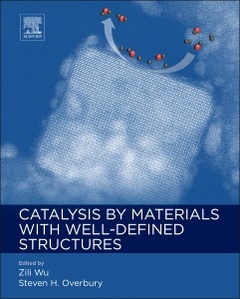Catalysis by Materials with Well-Defined Structures
Coordonnateurs : Wu Zili, Overbury Steven H.

Catalysis by Materials with Well-Defined Structures examines the latest developments in the use of model systems in fundamental catalytic science. A team of prominent experts provides authoritative, first-hand information, helping readers better understand heterogeneous catalysis by utilizing model catalysts based on uniformly nanostructured materials.
The text addresses topics and issues related to material synthesis, characterization, catalytic reactions, surface chemistry, mechanism, and theoretical modeling, and features a comprehensive review of recent advances in catalytic studies on nanomaterials with well-defined structures, including nanoshaped metals and metal oxides, nanoclusters, and single sites in the areas of heterogeneous thermal catalysis, photocatalysis, and electrocatalysis.
Users will find this book to be an invaluable, authoritative source of information for both the surface scientist and the catalysis practitioner
Catalysis by Materials with Well-Defined Structures
Preface
Zili Wu and Steven H. Overbury
Acknowledgment
Zili Wu and Steven H. Overbury
1. Crystal plane-dependent surface reactivity and catalytic property of oxide catalysts studied with oxide nanocrystal model catalysts
Weixin Huang
2. Ceria nano-shapes – structural and catalytic properties
Abhaya Krishna Datye
3. The Characterization and Structure-dependent Catalysis of Ceria with Well-defined Facets
Amanda K Peterson Mann
4. Gold clusters and nanoparticles stabilized by nanoshaped ceria in catalysis
Yejun Guan
5. Gold/Ceria: the making of a Robust Catalyst for Fuel Processing and Hydrogen Production
Nan Yi
6. Surface Effects in the Reactivity of Ceria: a First Principles Perspective
Michael Nolan
7. Applications of Electron Microscopy in Heterogeneous Catalysis
Yuyuan Lin
8. Catalysis by Atomically Precise Gold Nanoclusters
Rongchao Jin
9. Catalysis on Single Supported Atoms
Chaitanya K. Narula
10. Tailoring Nanoparticle Electrocatalysts for Proton Exchange Membrane Fuel Cells
Sen Zhang
11. Nano-Faceted Metal Surfaces: Structure, Reactivity and Applications
Wenhua Chen
12. Nano-Array Catalysts for Energy and Environmental Catalysis
Pu-Xian Gao
Academic researchers, industrial professionals in catalysis science, inorganic and physical chemistry, chemical engineering, material science, and physics. Graduate and undergraduate students in catalysis, material science, chemistry and chemical engineering.
Steven H. Overbury received a PhD in Physical Chemistry in 1976 from University of California, Berkeley, where he was advised by Prof. Gabor Somorjai. He then went to Oak Ridge National Laboratory where he has been since. He is currently Distinguished Research Staff and leads the Surface Chemistry and Heterogeneous Catalysis group within the Chemical Sciences Division at ORNL, has been a task leader in Nanocatalysis at ORNL’s Center for Nanophase Materials Sciences, and is currently a thrust leader in the FIRST Center.. His research interests are in the area of surface chemistry and catalysis including Au catalysis, catalysis by nanostructure carbon, and structure dependence in catalysis of oxygenates on CeO2 sur
- Outlines the importance of nanomaterials and their potential as catalysts
- Provides detailed information on synthesis and characterization of nanomaterials with well-defined structures, relating surface activity to catalytic activity
- Details how to establish the structure-catalysis relationship and how to reveal the surface chemistry and surface structure of catalysts
- Offers examples on various in situ characterization instrumental techniques
- Includes in-depth theoretical modeling utilizing advanced Density Functional Theory (DFT) methods
Date de parution : 04-2015
Ouvrage de 392 p.
19x23.3 cm
Thèmes de Catalysis by Materials with Well-Defined Structures :
Mots-clés :
Aberration correction; Adsorption; Atomic surface structures; Catalysis; CeO2; Ceria; Ceria nanoshapes; Cerium oxide; Characterization; CO oxidation; Crystal plane; Cu2O; Density functional theory; DFT of single supported atoms; Doping; Electrocatalysis; Electron microscopy; ETEM; Faceting; Formation energy; Formic acid oxidation reaction; Fuel cells; Gold; Gold catalysts; Heterogeneous catalysis; HREM; Hydrocarbon combustion; Hydrogen production; Mechanistic studies; Methanol; Methanol oxidation reaction; Model catalyst; Nano-array catalysts; Nanocluster; Nanoparticle; Nanoparticles; Nanoshaped; Nanostructure; Nanotemplate; Oxidation; Oxide nanocrystal; Oxygen reduction reaction; Oxygen vacancy; Photocatalysis; Redox reactions; SEM; Single atom catalysis; Size effects; STEM; Structure; Structure dependence; Supported; Supported Pt atoms; Surface chemistry; Surface facets; Surface reactivity; Surface structure; Surfaces; TEM; Water gas shift; Water-gas shift; Well-defined catalyst



